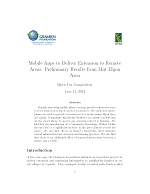Mobile Financial Service Providers Must Factor Local Differences in Access & Usability
February 19, 2014

February 19, 2014

These studies aim to understand how mobile phone technology and its usability is impacting poor women’s ability to access and benefit from mobile financial services. Many players assume that if a poor person owns a mobile phone, they are able to use it. We have found that this is a faulty assumption, and believe that usability and “mobile phone literacy” are big issues that are preventing poor women in particular to benefit from mobile-enabled solutions.
December 19, 2013

This case study analyzes Cashpor’s Business Correspondent (BC) model from a business sustainability perspective.
This case study looks at how an existing channel of delivery can be improvised and customized to effectively reach and serve the poor in a sustainable way.
 This study finds that the introduction of a Community Knowledge Worker within the area led to a signicant increase in the price farmers receive for maize. It also finds effects on farmer's knowledge, their attitudes toward information and extension and farming practices.
This study finds that the introduction of a Community Knowledge Worker within the area led to a signicant increase in the price farmers receive for maize. It also finds effects on farmer's knowledge, their attitudes toward information and extension and farming practices.
 Prevailing wisdom holds that the ultra-poor are too poor to save money. This study examines the savings behavior of ultra-poor women served by the Livelihood Pathways for the Poorest project, which is jointly implemented by Grameen Foundation and the Livelihood School (part of BASIX group of companies), in Gaya District, Bihar, India.
Prevailing wisdom holds that the ultra-poor are too poor to save money. This study examines the savings behavior of ultra-poor women served by the Livelihood Pathways for the Poorest project, which is jointly implemented by Grameen Foundation and the Livelihood School (part of BASIX group of companies), in Gaya District, Bihar, India.
 In this study, Grameen Foundation reviews microfinance institutions' (MFIs) experiences with mobile financial services and assesses the challenges and opportunities faced during implementation.
In this study, Grameen Foundation reviews microfinance institutions' (MFIs) experiences with mobile financial services and assesses the challenges and opportunities faced during implementation.
 The mobile phone is gaining widespread popularity as a means to bridge the “last mile” – to bring information and financial services to people without ready access to them. To get a better picture of how to best deliver mobile services, we conducted a case study with our partner, Cashpor Microcredit, based in Varanasi, India.
The mobile phone is gaining widespread popularity as a means to bridge the “last mile” – to bring information and financial services to people without ready access to them. To get a better picture of how to best deliver mobile services, we conducted a case study with our partner, Cashpor Microcredit, based in Varanasi, India.
 For over 30 years, microfinance institutions (MFIs) have been successfully serving some of the poor and poorest people around the world, primarily with credit products. Generally however, MFIs grapple to successfully add savings services to their portfolio of financial products.
For over 30 years, microfinance institutions (MFIs) have been successfully serving some of the poor and poorest people around the world, primarily with credit products. Generally however, MFIs grapple to successfully add savings services to their portfolio of financial products.